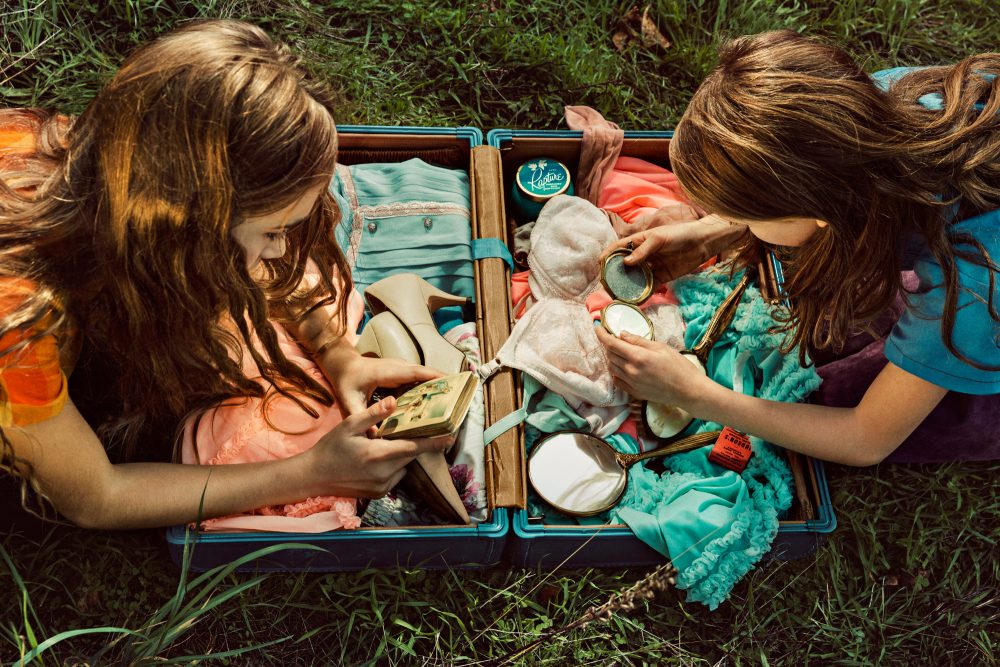First Blush Elk Rock Island by Holly Andres
- Title: First Blush Elk Rock Island
- Artist: Holly Andres
- Medium: Chromogenic dye coupler print
- Size: 28"h x 42"w
- Creation date: 2015
- Added to collection: 2016
- Donor: Purchased by Portland Community College, Rock Creek Campus
- Campus: Rock Creek
- Location: B5/1 N/S Hallway gallery
The theatrical photographic work of Holly Andres is a mash-up of Nancy Drew mysteries, the stylish palette of Wes Anderson films and slick fashion photography. Her images of actors (arranged in sets and costumes of saturated color with theatrical lighting) alternate between moments of high melodrama and poetic stillness. This image, presented like production still from a non-existent film, is part of the Fallen Fawn series of photographs Andres made in 2015. Her artistic statement reads like corny tag-lines for movies: "The suitcase contained everything the woman had left. At nightfall, the sisters ran their fingers through her box of burdens, applied her makeup, their lips kissed by the secrets of the Fallen Fawn."
The photographs in this series are a storyboard beginning with the opening image a fawn standing in a field at night, caught in the headlights of a turquoise 1950's Rambler. Next we see the dashboard in close-up in which a turquoise vintage suitcase on the passenger seat is caressed by a woman's hand decorated with bright red nail polish amid swirls of cigarette smoke. The third image introduces two adolescent girls walking on a path by a lake the next day discovering the turquoise suitcase abandoned under a tree. They go through the suitcase (above). Next, alongside the car we see the orange body of a dead fawn. We cut to the girls' bedroom at night, the turquoise suitcase glimpsed under the bed. There is a flashback to the lake in which a woman's shoe floating in the water implies the woman has drowned. In the ensuing images we see the girls in their room putting on the woman's lipstick and clothing or sneaking out to revisit the car (above), and these are intercut with images of the girls and their parents grimly sitting at the dinner table, saying grace in front of unappetizing plates of steak and mashed potatoes. The mother, whose face is not shown, wears turquoise. During the meal the girls exchange glances and we cut to a scene of them letting the suitcase slowly sink into the lake. The series ends with the two girls asleep in their room, reflected in an oval vanity mirror flanked by toys and in the center the woman's red lipstick lies open on the table. The elegance of framing, color design and repeated imagery are richly cinematic and poetic. The story was based on a childhood experience of Andres' older sisters, who found an abandoned suitcase belonging to a mystery woman. "My sisters (two curious and naive girls) could have unearthed a treasure trove containing a sinister secret. The Fallen Fawn is sequenced in such a way to illustrate the two parallel narratives of the sisters discovering the suitcase and the subsequent consequences of harboring this secret. Additionally, the implicit tale of the woman, dubbed 'The Fallen Fawn,' is revealed through her deserted belongings. I chose to depict the woman through her personal objects, thinking of them as clues strewn throughout the woods."
View the whole series at hollyandres.com/the-fallen-fawn-1
Like her idol Cindy Sherman, whose "Untitled Movie Stills" in the late 1970's were self portraits in the disguises of various female film characters familiar from Hollywood or European arthouse films, and the photographer Gregory Crewdson whose elaborate cinematic tableaux vivants seem like high production Hollywood film stills, Andres evokes the clichés of cinema to create narratives in the viewer's mind. But unlike Sherman and other artists of the Pictures Movement Generation who used borrowed images to expose cultural tropes and stereotypes and question ideas of authorship, Andres is fully immersed in the illustrated picture story as a form; cultural critique has been replaced by earnest illustrative storytelling.

